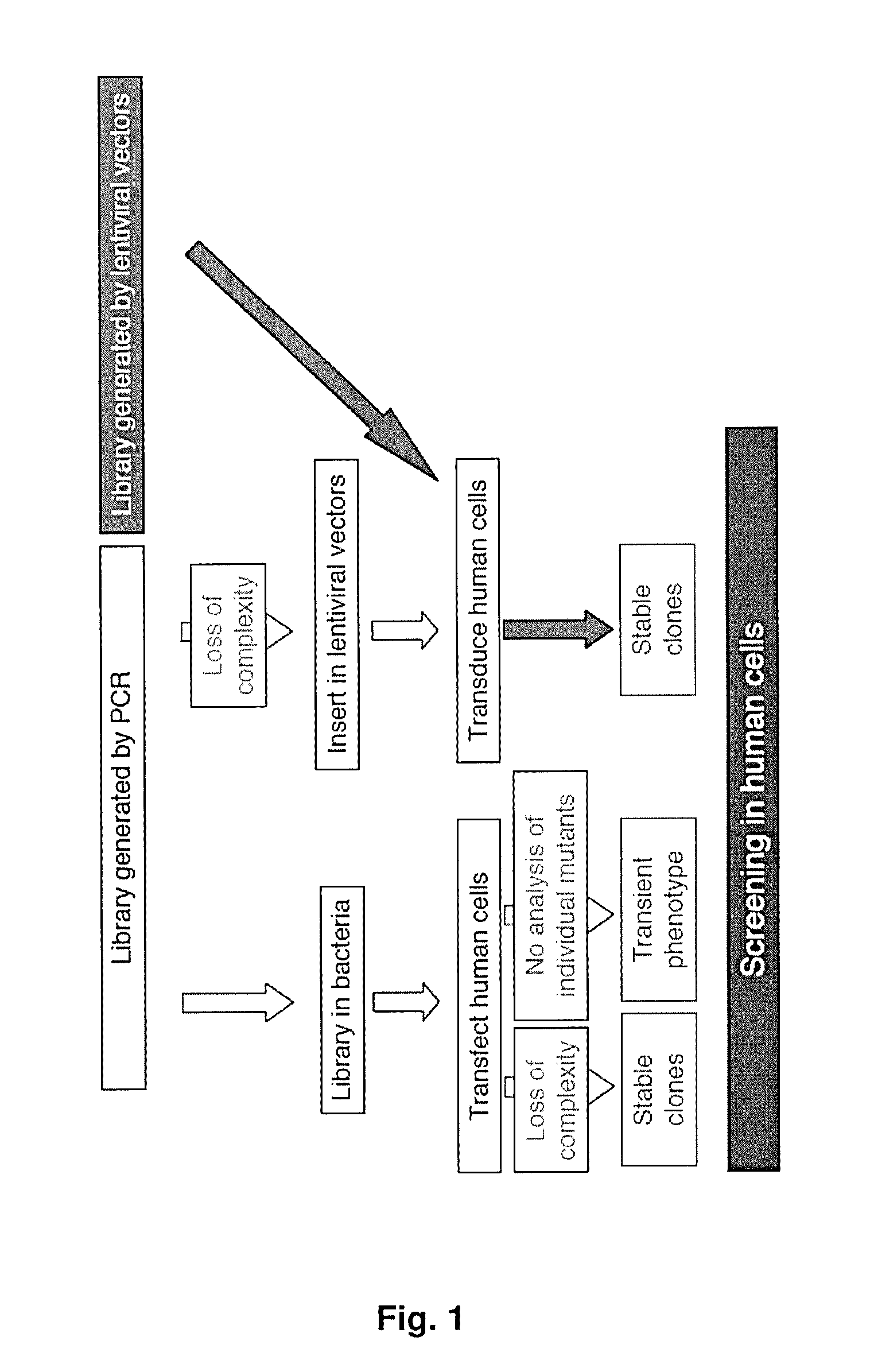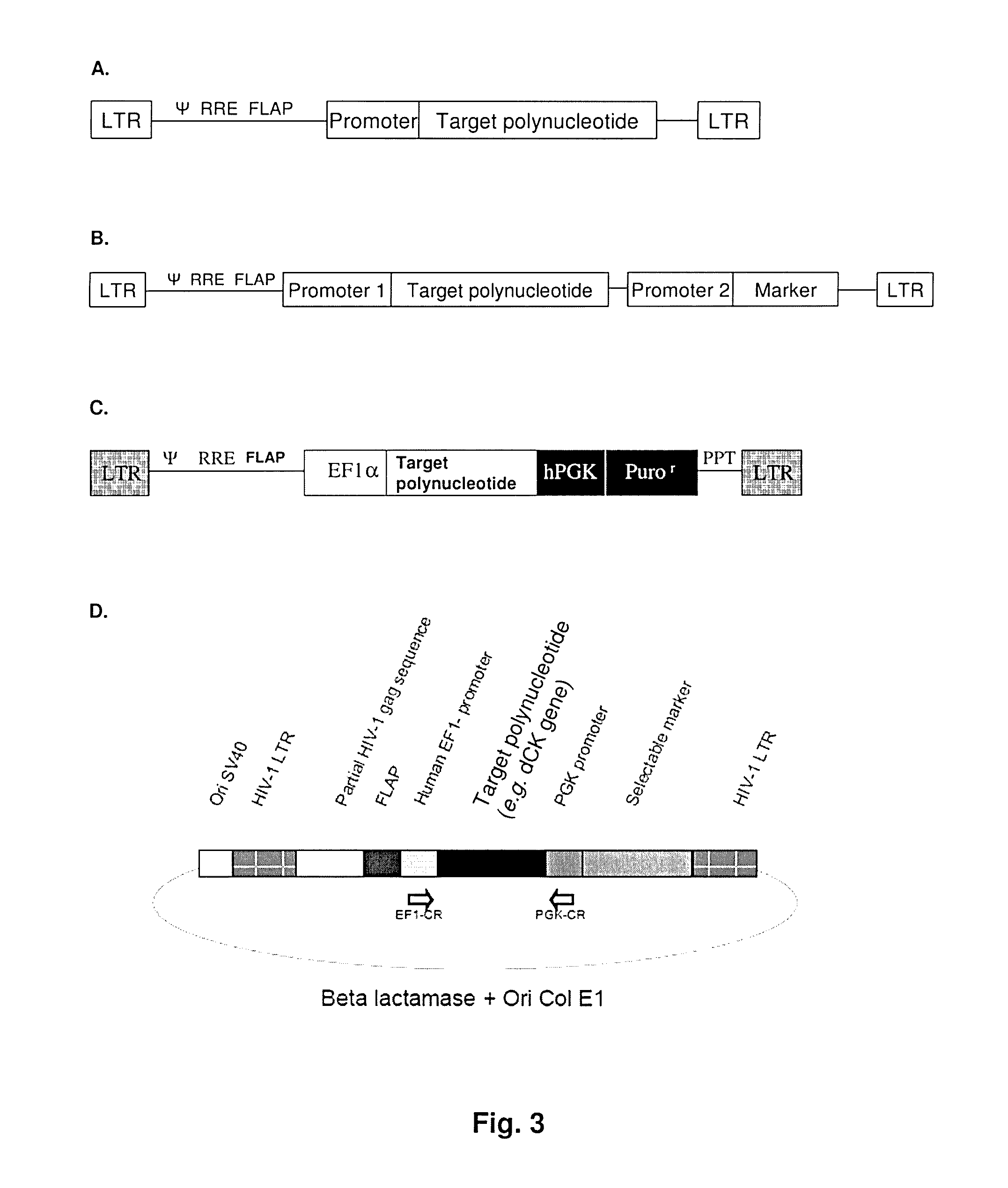Lentiviral-based vector and its use in directed evolution of genomic regions, genes and polynucleotides
a lentiviral-based, genomic technology, applied in the direction of transferases, directed macromolecular evolution, library creation, etc., can solve the problems of inefficient conferring a tk+/sup> phenotype to tk-human cells in culture, the application limit is extremely limited, and the desired phenotype is not achieved. , to achieve the effect of increasing the repertoire of genetic combinations, amplifying genetic variability, and increasing the complexity of variants
- Summary
- Abstract
- Description
- Claims
- Application Information
AI Technical Summary
Benefits of technology
Problems solved by technology
Method used
Image
Examples
example 1
Genetic Variability Generated in the dCK Gene
Materials and Methods
[0123]Plasmids: The SDY-PdCK plasmid was constructed in the laboratory and the map is provided in FIG. 3D. pCMVΔR8.2 (Naldini L., Blomer U., Gallay P., Ory D., Mulligan R., Gage F. H., Verma I. M. and Trono D. (1996) Science, 272, 263-267) is a plasmid encoding HIV-1 Gag, Pol, and accessory proteins, and pHCMV-G (Yee J. K., Miyanohara A., LaPorte P., Bouic K., Burns J. C. and Friedmann T. (1994) P.N.A.S., 91, 9564-9568) encodes the VSV envelope protein.
[0124]Cells: HEK 293T cells are grown in Dulbecco's modified Eagle's medium supplemented with 10% fetal calf serum, penicillin and streptomycin (Invitrogen), and maintained at 37° C. with 5% CO2.
Nomenclature of Cell Lines and Viral Generations
[0125]Each viral generation is named V-FXdC, where “V” stands for virus (replication-defective lentiviral particles), “FX” for the generation (“FP” stands for parental viral generation; “F3” stands for third viral generation) and “...
example 2
Genetic Variability Generated in the Adaptor Protein SLP-76
[0156]Introduction
[0157]The evolution of SLP-76, an adaptor protein involved in signalling in response to T cell receptor activation, was also performed with the same procedure used for the dCK gene. The goal of targeting an adaptor protein is to provide an example of how our directed evolution system is adapted for studying the functionality of this important type of proteins. Indeed, activation of signalling pathways (as the lymphocyte differentiation pathway in which SLP-76 is involved) depends on several enzymes such as protein kinases and phosphatases, phospholipases, GTPases, but also on scaffolds and adaptors. These proteins are responsible for the recruitment of effectors in supra-molecular complexes, where the ordered activation of the various binding partners is regulated.
[0158]Analysis of scaffold and adaptor proteins function has been often carried out using gene knockout or overexpression. These approaches have ...
example 3
Genetic Variability Generated in the Gene Encoding the Interferon Lambda
[0172]IFN λ exhibits several common features with type I IFNs since they share a signalling pathway involving the transcription factor ISGF3, driving the expression of a common set of responsive genes (Dumoutier L., Lejeune D., Hor S., Fickenscher H., Renauld J. C. (2003) Biochem. J. 370: 391-6; Kotenko S. V., Gallagher G., Baurin V. V., Lewis-Antes A., Shen M., et al. (2003) Nat. Immunol., 4: 69-77; and Sheppard P., Kindsvogel W., Xu W., Henderson K., Schlutsmeyer S., et al. (2003) Nat. Immunol., 4: 63-8). Consequently, IFN λ is able of establishing an antiviral state in sensitive cell lines and it possesses an antiproliferative activity (Meager A., Visvalingam K., Dilger P., Bryan D., Wadhwa M. (2005) Cytokine, 31: 109-18). IFN λ is of potential interest with respect to type I IFNs, due to the cell specific expression of their receptor in contrast to the ubiquitous presence of receptors for type I IFNs.
[0173]T...
PUM
| Property | Measurement | Unit |
|---|---|---|
| volume | aaaaa | aaaaa |
| volume | aaaaa | aaaaa |
| concentration | aaaaa | aaaaa |
Abstract
Description
Claims
Application Information
 Login to View More
Login to View More - R&D
- Intellectual Property
- Life Sciences
- Materials
- Tech Scout
- Unparalleled Data Quality
- Higher Quality Content
- 60% Fewer Hallucinations
Browse by: Latest US Patents, China's latest patents, Technical Efficacy Thesaurus, Application Domain, Technology Topic, Popular Technical Reports.
© 2025 PatSnap. All rights reserved.Legal|Privacy policy|Modern Slavery Act Transparency Statement|Sitemap|About US| Contact US: help@patsnap.com



